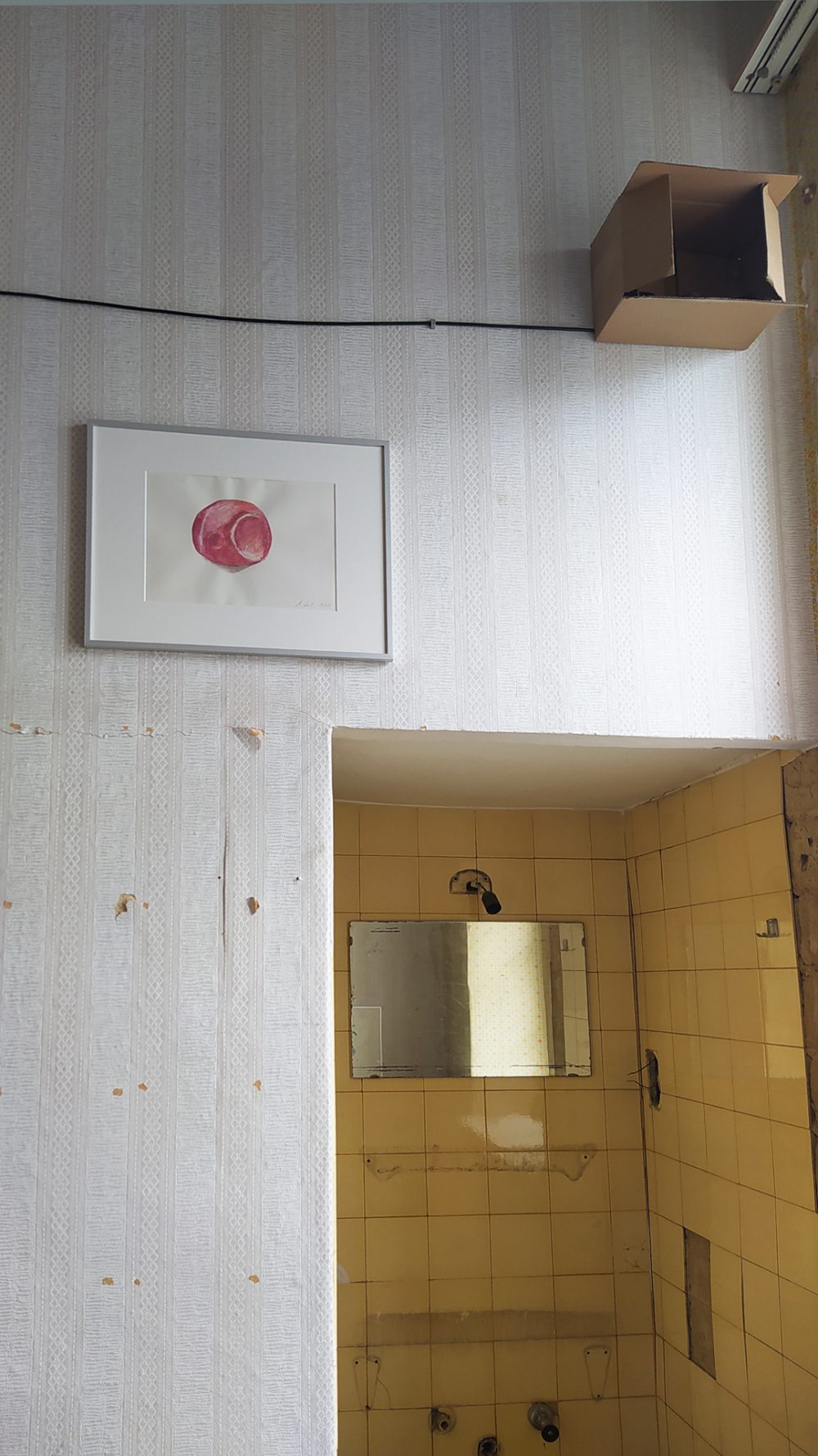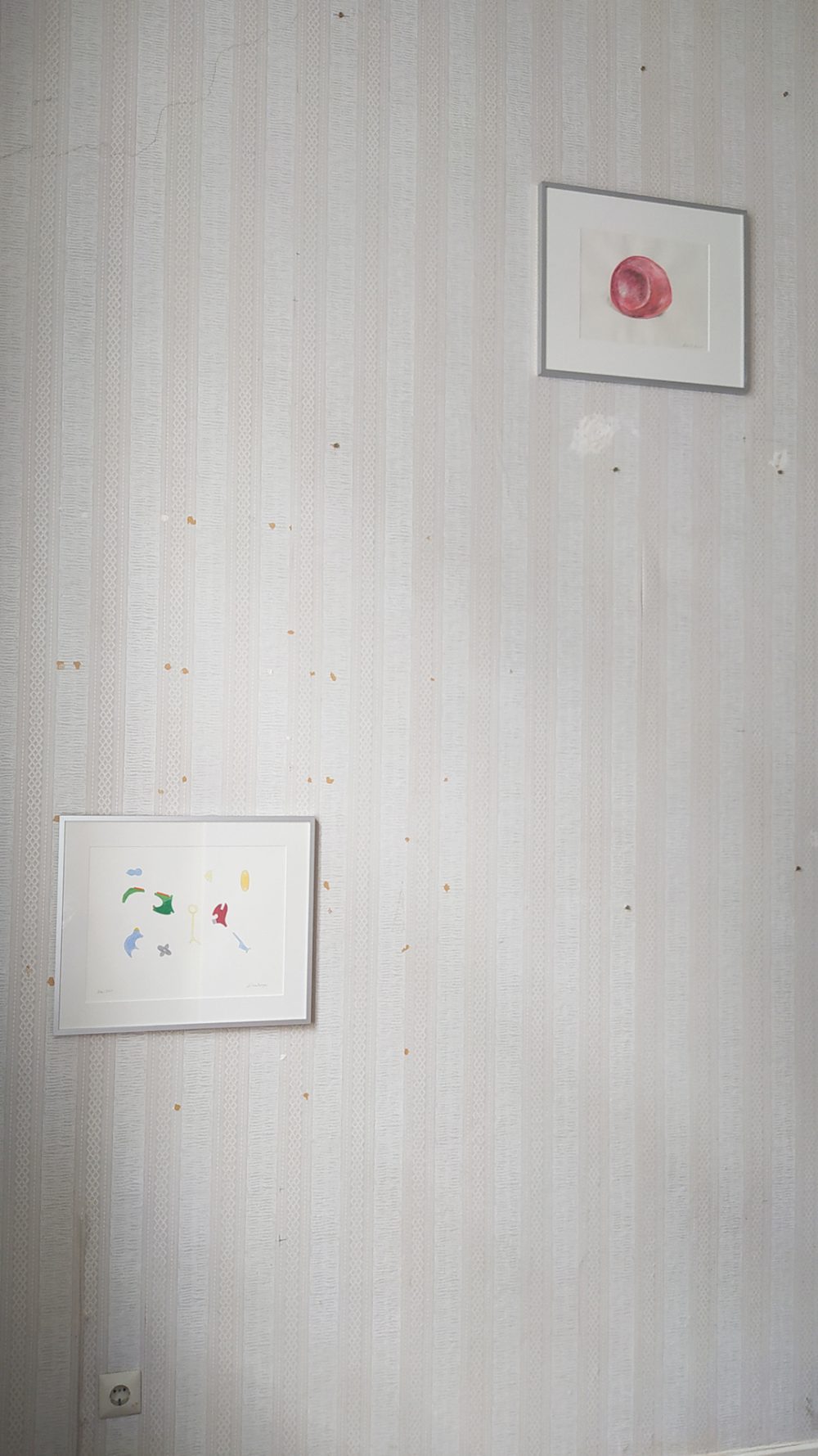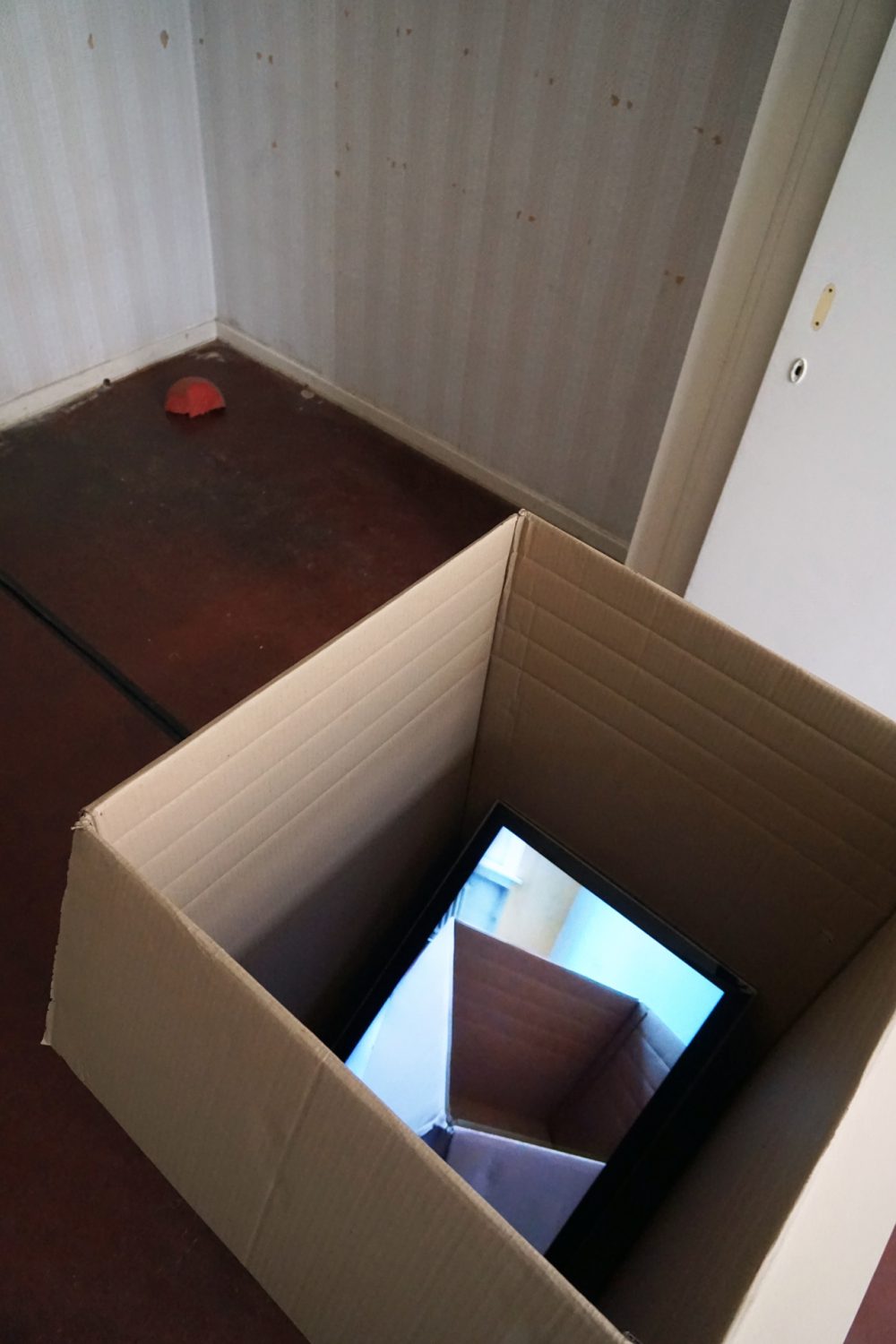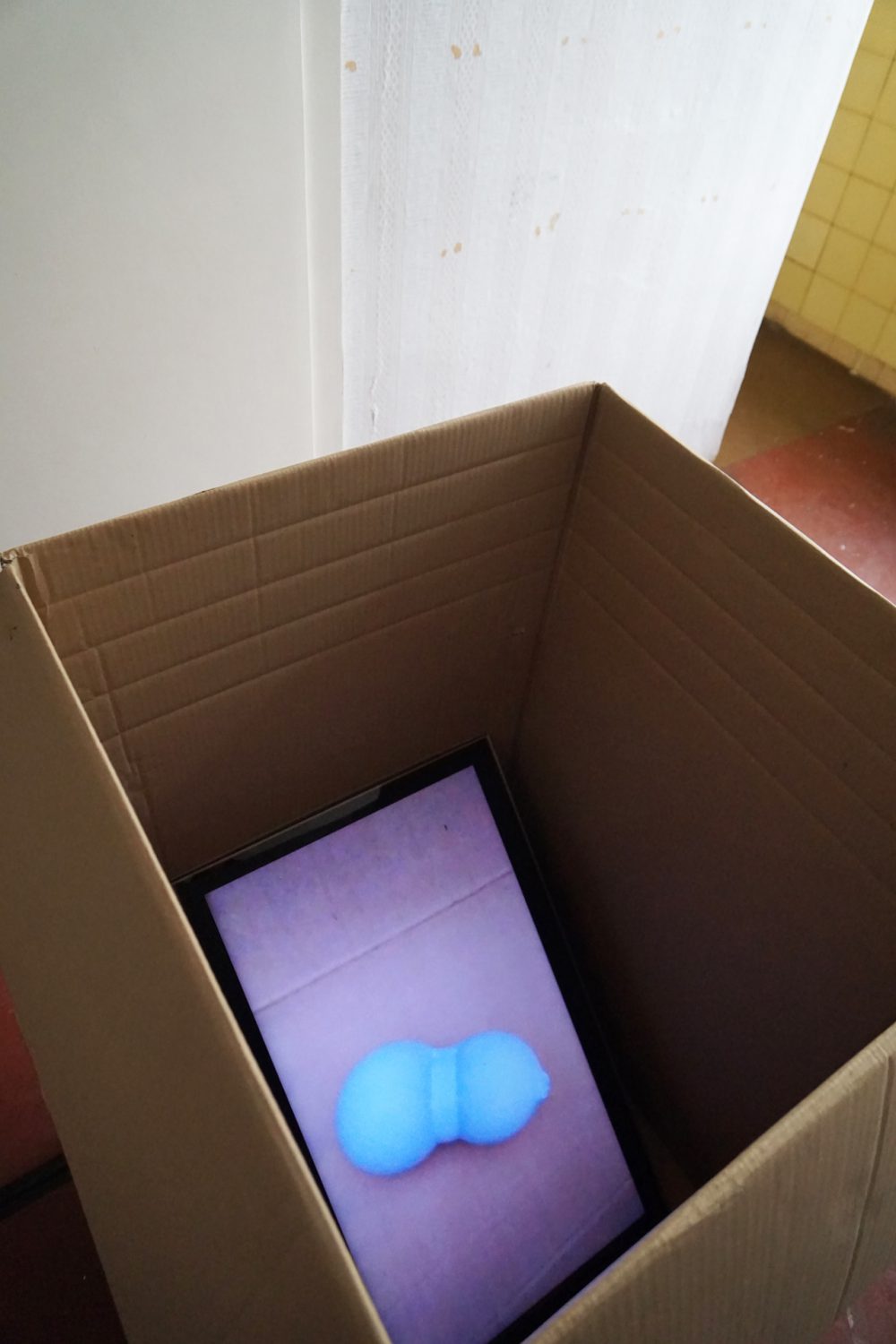still alive
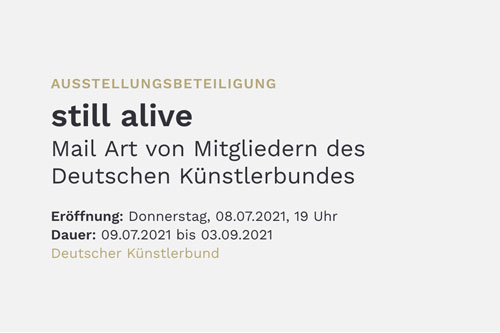
AUSSTELLUNGSBETEILIGUNG
still alive
Mail Art von Mitgliedern des Deutschen Künstlerbundes
Doppelzimmer
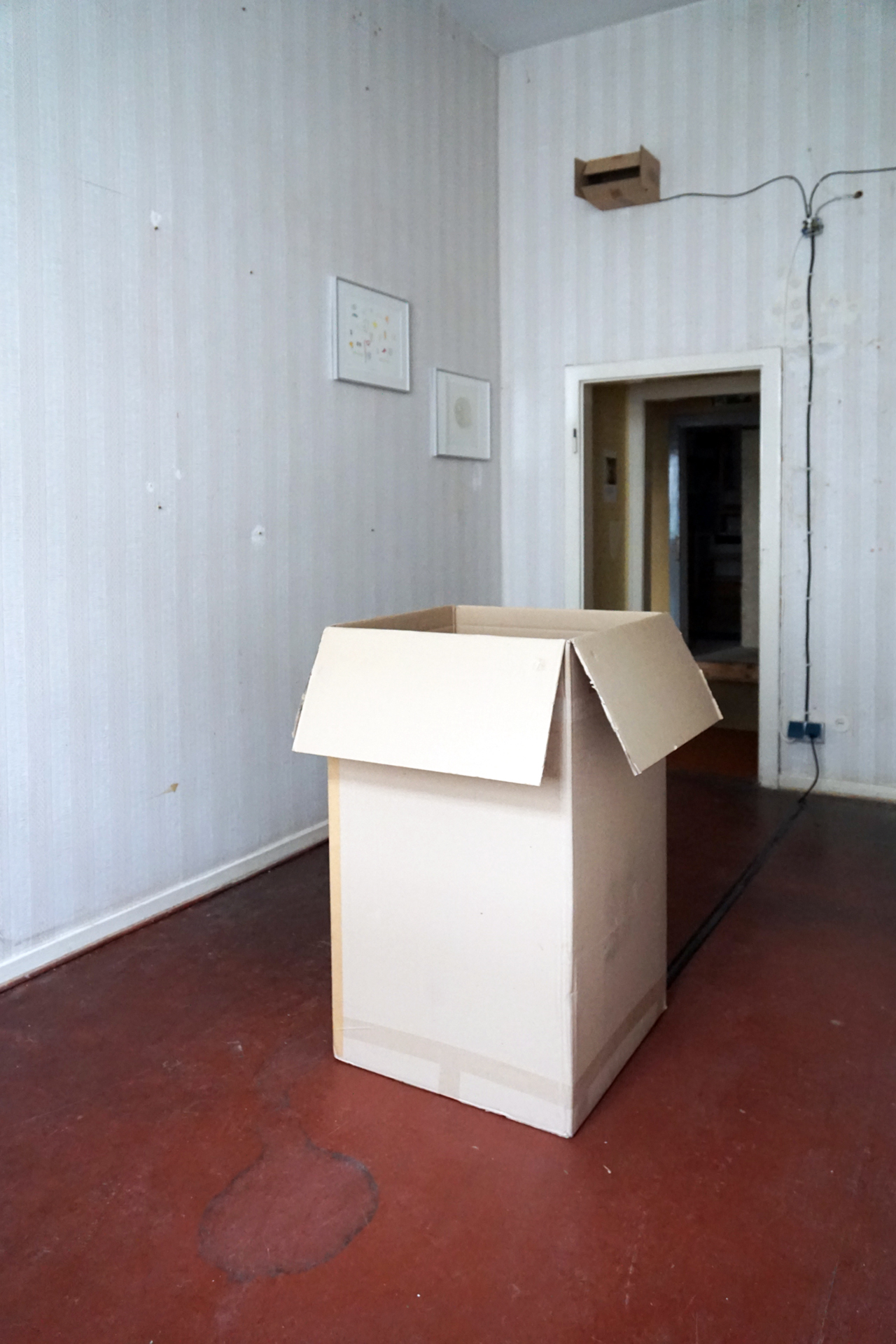
AUSSTELLUNG
In Präsenz und Abwesenheit
„In Präsenz und Abwesenheit“ (Objekt, Zeichnung, Video, Sound) ist eine multimediale Installation, die zusammen mit Johannes Sandberger in der Ausstellung „Doppelzimmer“ zu sehen war. Die Objekte der beiden und sind nur im Video zu sehen, im Wechsel mit Kamerafahrten durch den Raum, einige wenige sind auch auf den Zeichnungen zu sehen. Der Sound ist von Johannes Sandberger, drei Loops unterschiedlicher Länge mischen sich immer wieder neu.
Hugenottenhaus
Friedrichsstrasse 25
34117 Kassel
16. Juli bis 26. September 2021
Die Künstlerliste und weitere Informationen unter:
hugenottenhaus.com
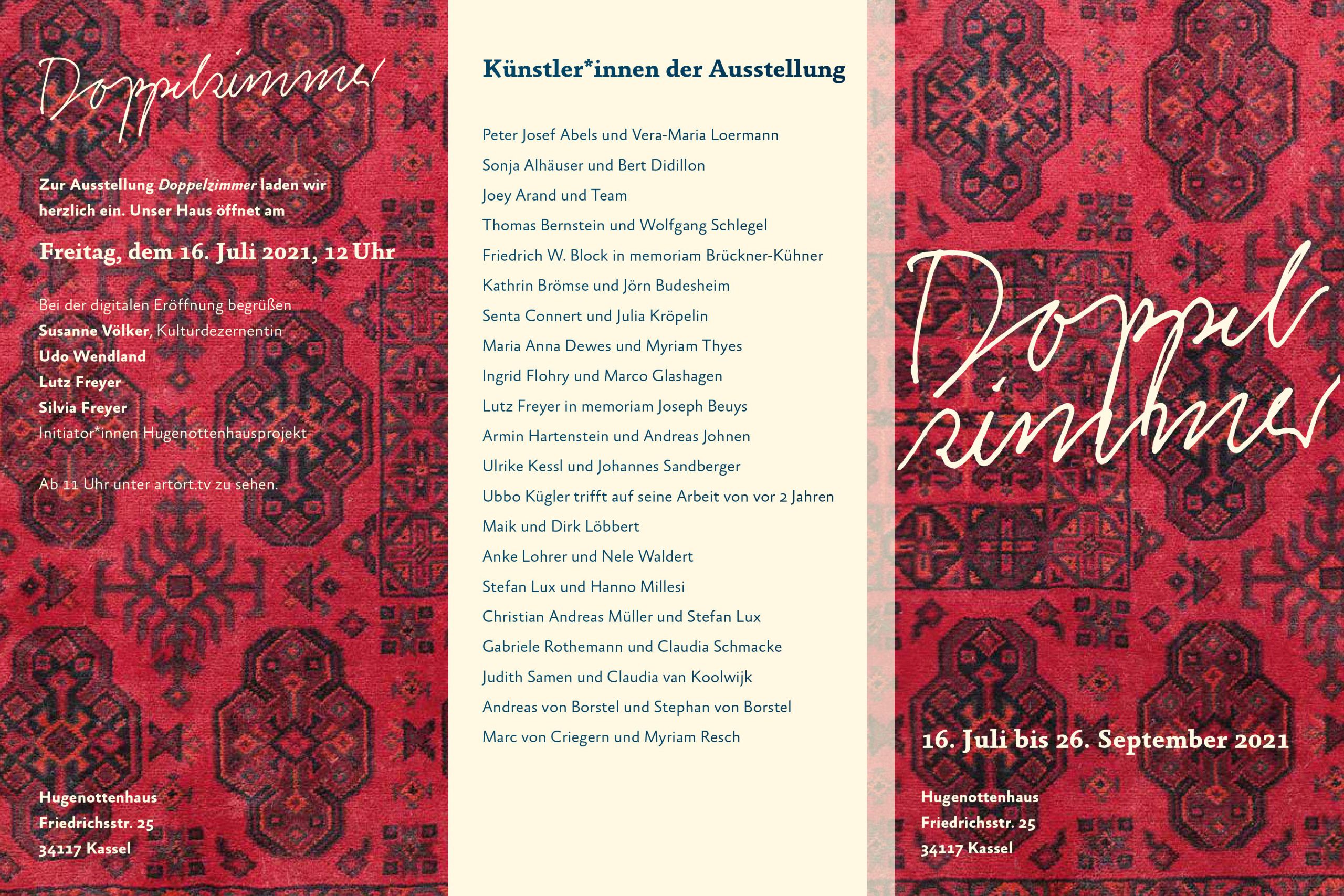
Fliegende Stühle
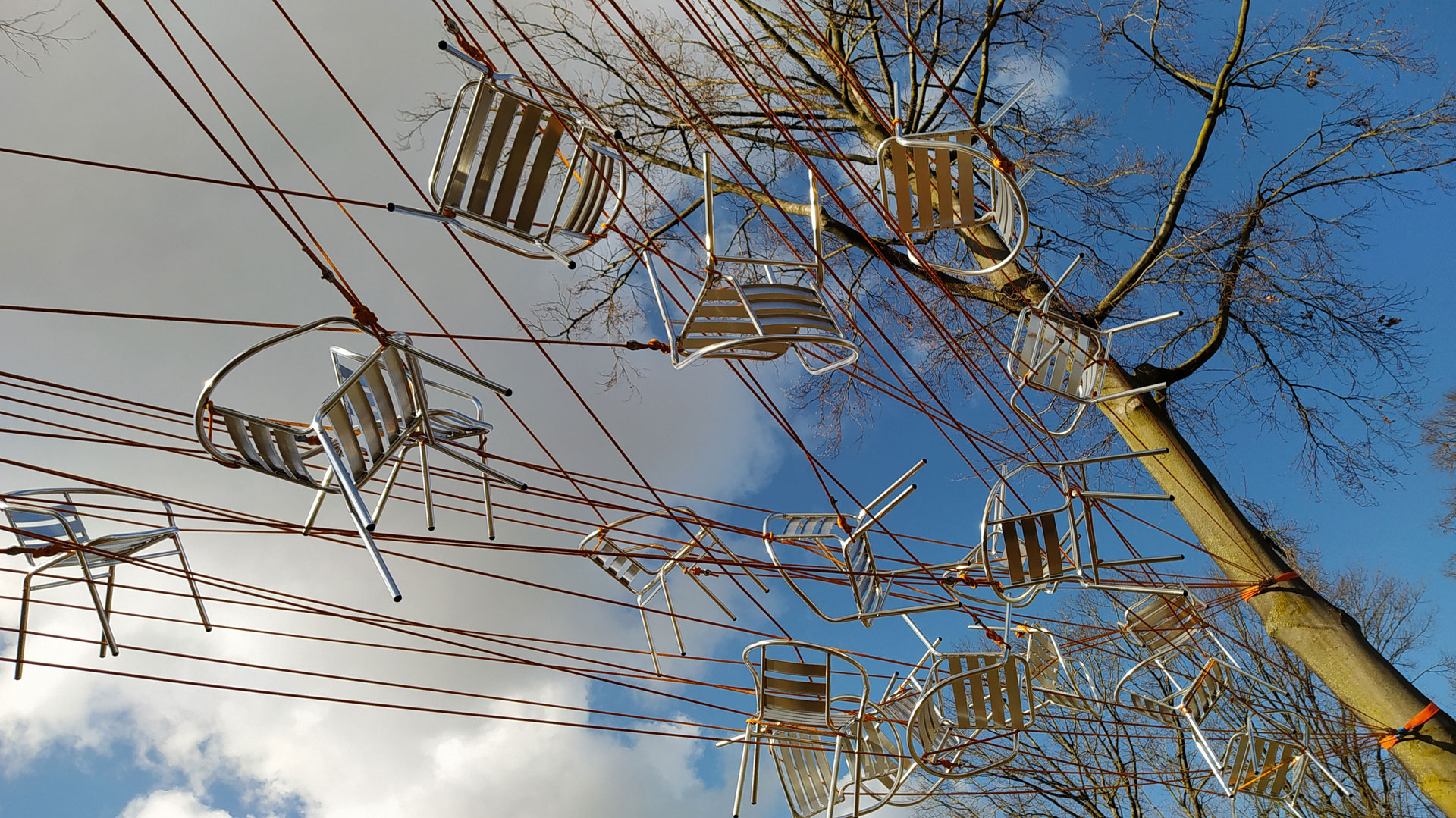
AUSSTELLUNG
Kunst-Radroute „FahrArt“
Fliegende Stühle, De Wittsee, Nettetal
Am Wittsee 25
41334 Nettetal-Leuth
Die Skulptur „Fliegende Stühle“ ist Teil der Kunst-Radroute „FahrArt“, Mai 2021- Mai 2023
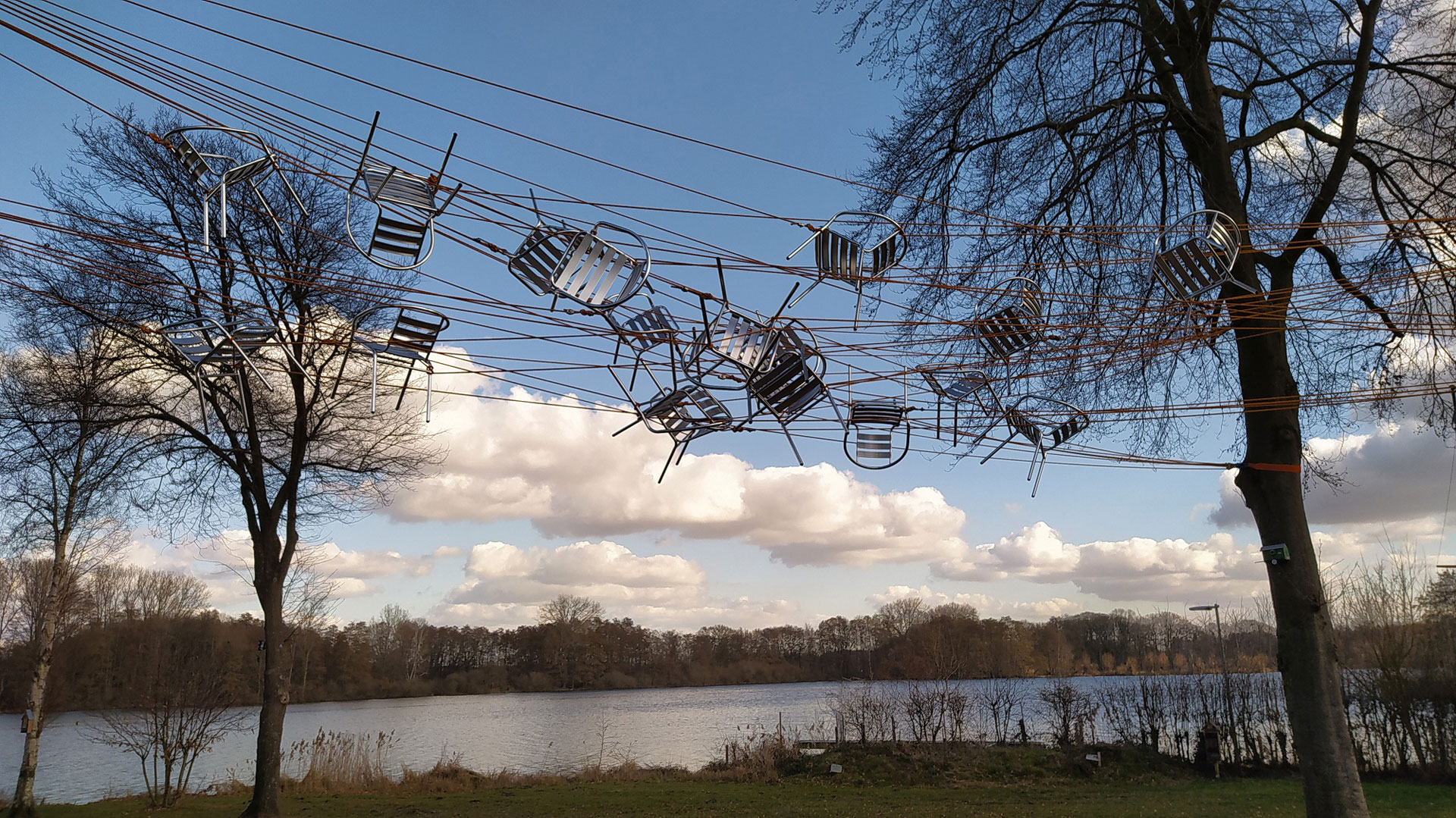


ULRIKE KESSL, Fliegende Stühle, 2021
Der Traum vom Wohnen
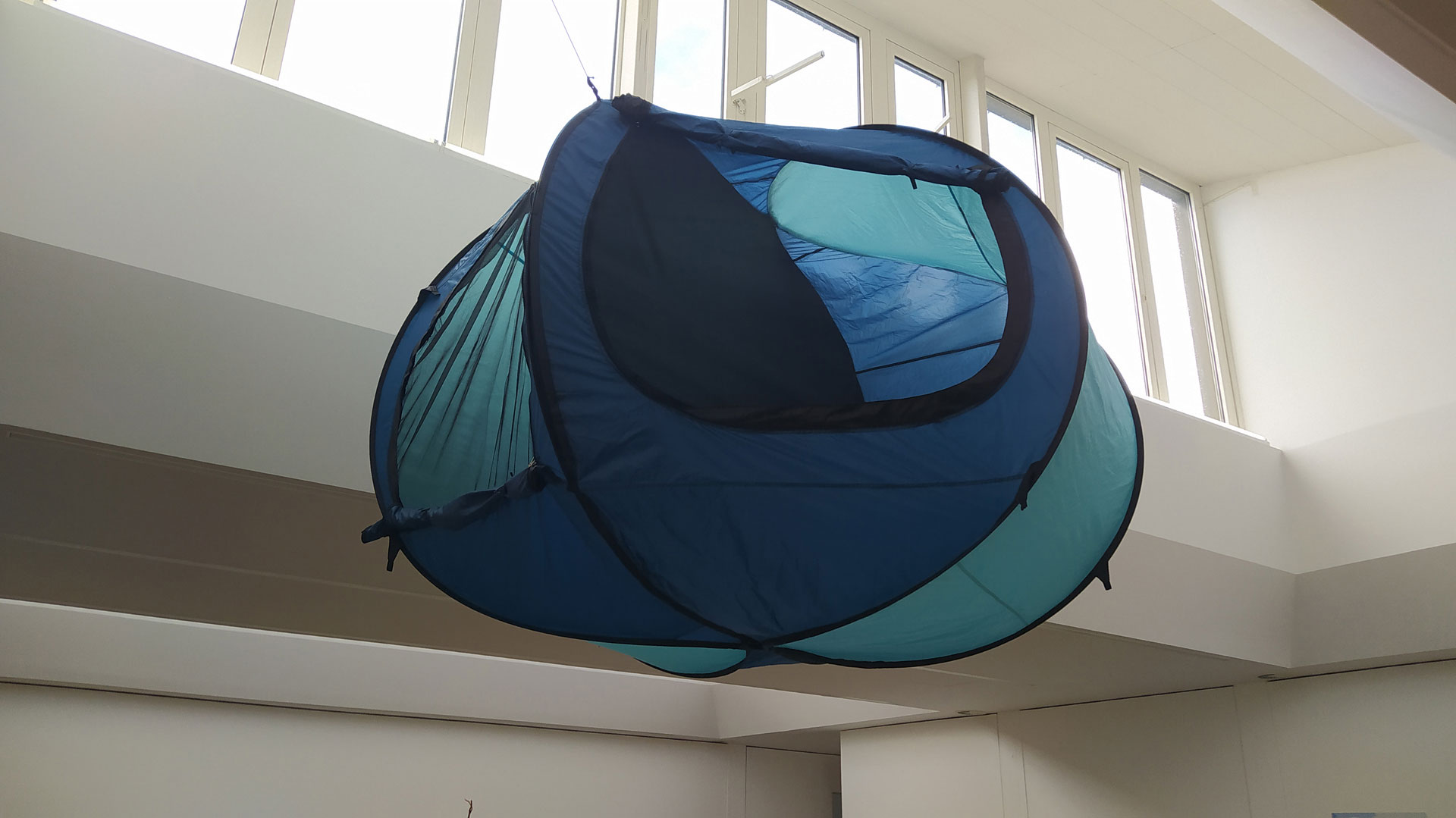
AUSSTELLUNG
Der Traum vom Wohnen
Museum Ratingen, 7. Mai – 1. November 2021
KünstlerInnen: Hörner/Antlfinger, Ulrike Kessl, Neringa Naujokaite, Driss Ouahadi, Veronika Peddinghaus
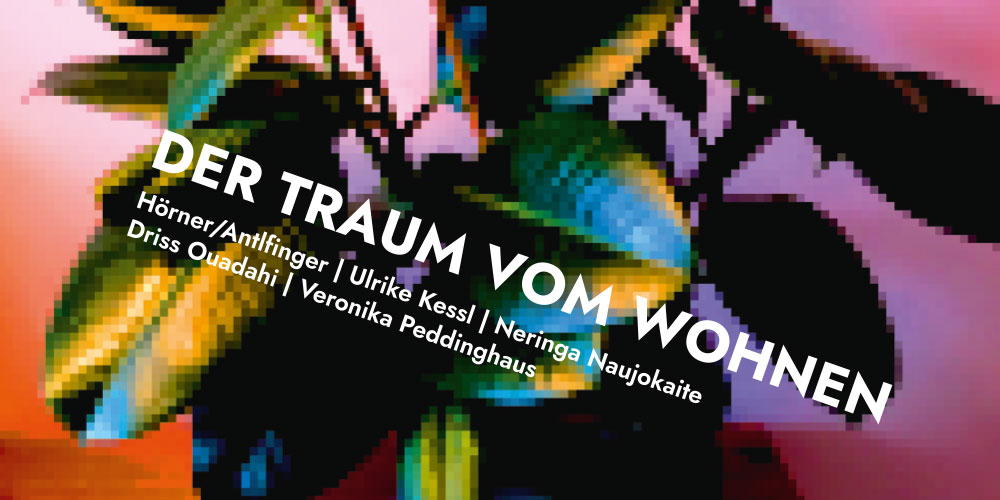
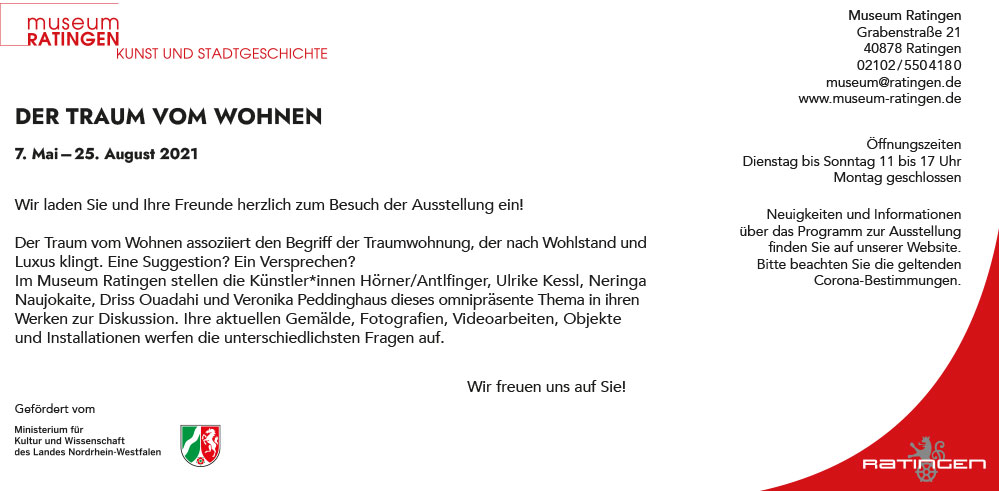

ULRIKE KESSL, Zeltkapsel, 2019
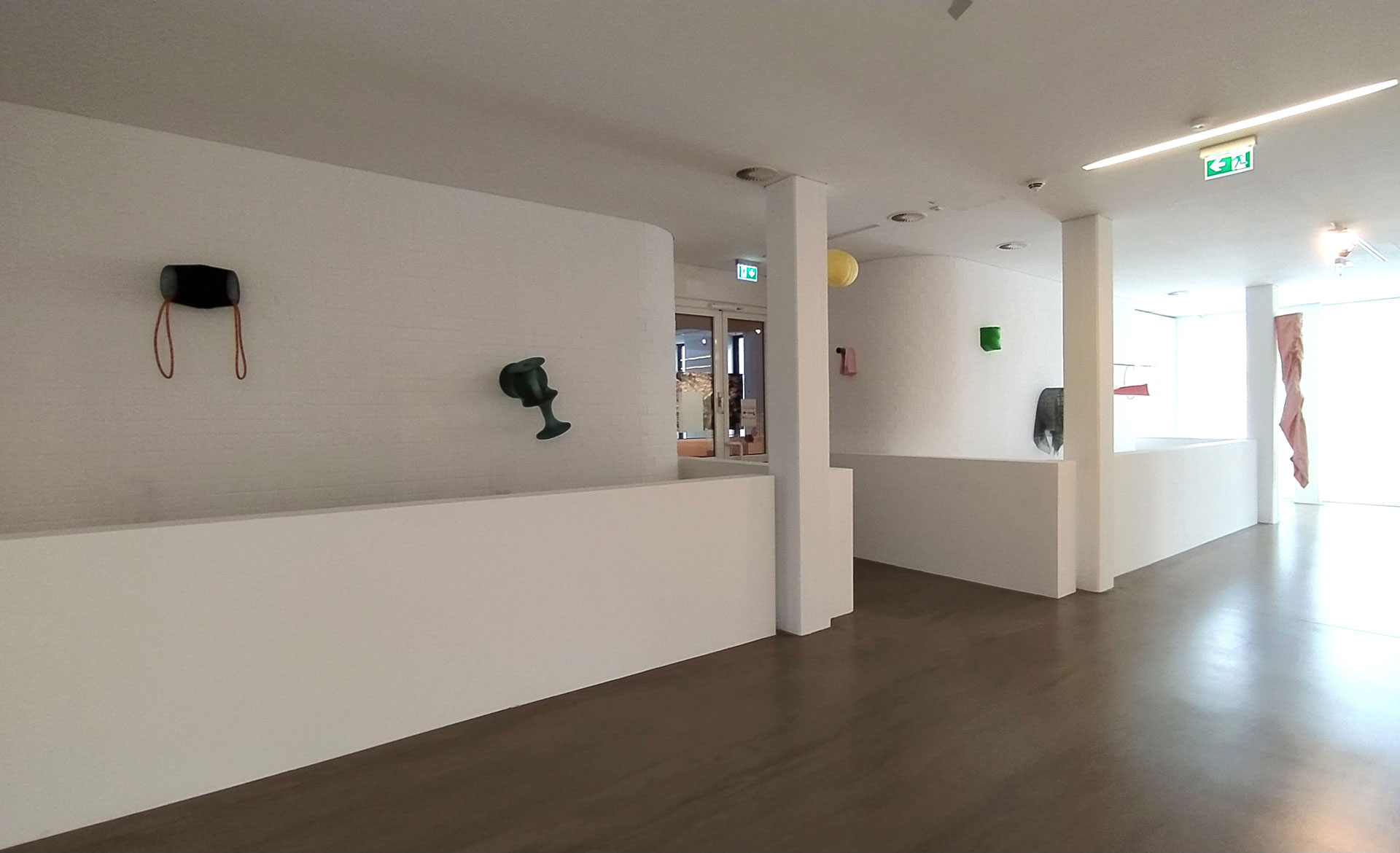
ULRIKE KESSL, Ensemble living“ (7teilig), 2021
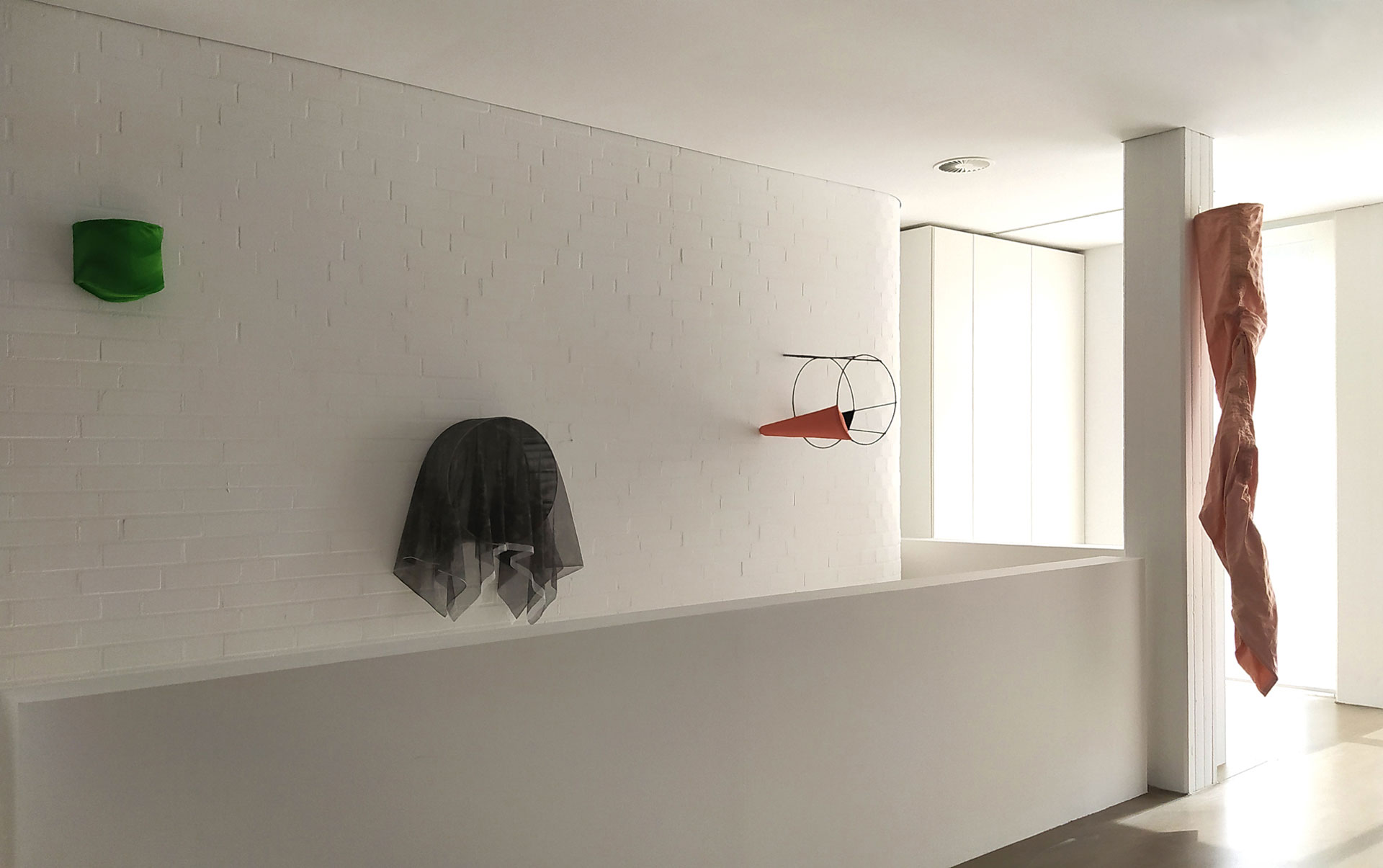
ULRIKE KESSL, Ensemble living“ (7teilig), 2021
Kunst und KSK II
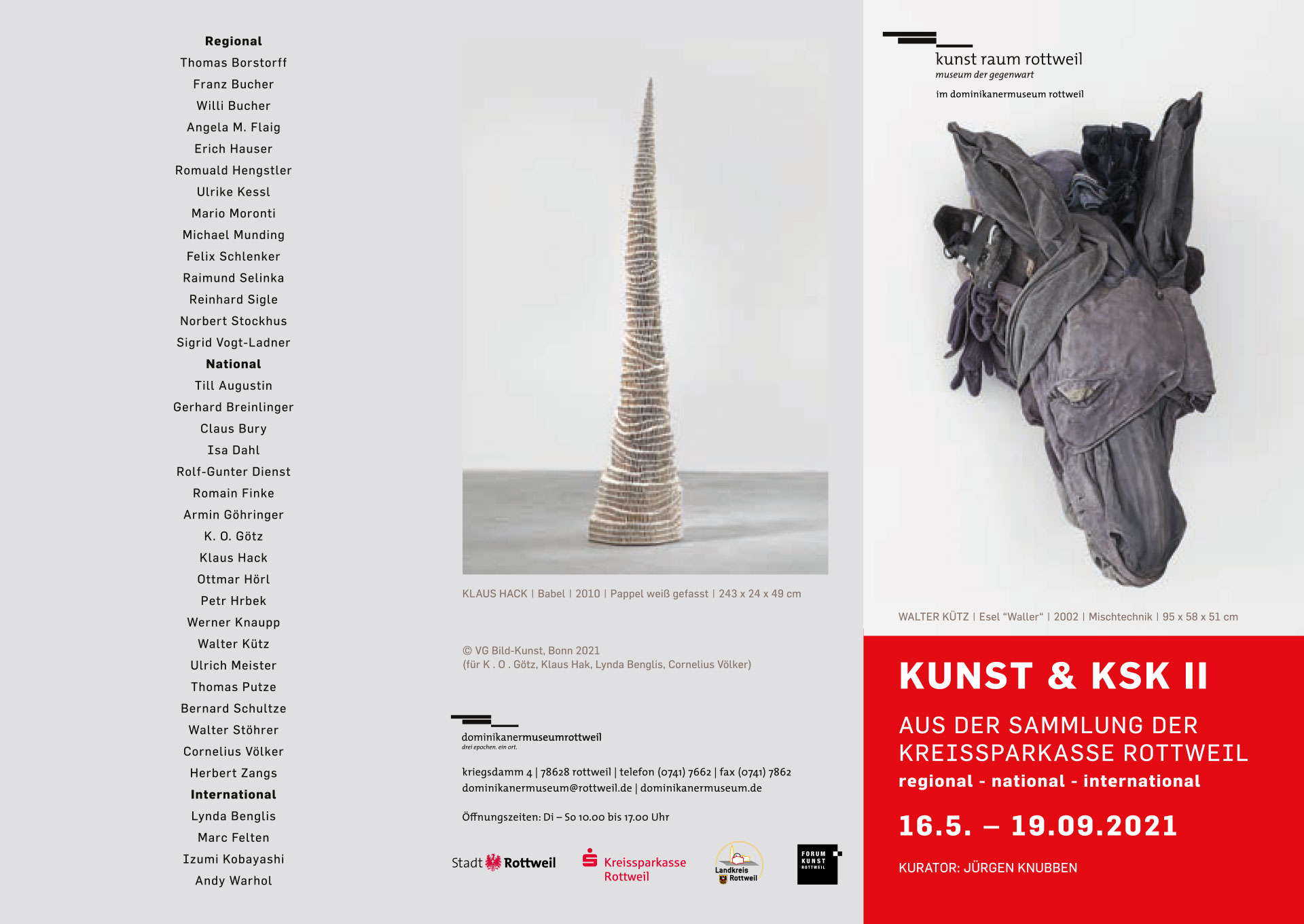
AUSSTELLUNG
KUNST & KSK II
kunst raum rottweil, 16. Mai – 19. September 2021

Ausstellungsflyer
Bühne der verkörperten Begegnung
TEXTE
Rita Kersting, 1997
Bühne der verkörperten Begegnung
Die Waage ist ein recht unbarmherziges Instrument, das nichts weiter tut
als eine Zahl zu zeigen, die das Gewicht unseres Körpers angibt. Es ist
eine anonyme, jedoch spezifische, eine objektive, jedoch individuelle
Ziffer,die uns erschreckt oder erfreut, abhängig von den Erwartungen und
vorangegangenen Maßhaltungen, mit denen wir die Waage besteigen. Oft
jedoch hinterläßt die Selbstbegegnung mit dieser abstrakten Zahl,
ähnlich wie beim Lesen der persönlichen Paßnummer, eine Leere, eine
innere Gleichgültigkeit. Sie bestätigt unsere Existenz, teilt uns aber
über uns selbst nichts mit.
Ulrike Kessl hat in Rheine eine Waage auf dem `Thie´ platziert, die
dreißig Jahre lang in einer Textilfabrik Garnspulen auswog. Dieser
Funktion enthoben erhält die Waage im Ausmusterungsalter an öffentlichem
Ort eine neue, die Kessl ermöglicht, aber nicht ausformuliert. Die
große Wiegefläche ist bündig in den Boden eingelassen, so daß keine
Hemmschwelle die Bummelnden von der Benutzung des Kunstwerks abhält, das
sich auf den ersten Blick ästhetisch von den platzgestaltenden
Schildern, Baumgittern und Laternen nicht unterscheidet, gleichwohl bei
näherer Betrachtung einen deplatzierten und leicht absurden Eindruck
macht. Dabei greift Ulrike Kessl mit der Waage auf ein traditionell von
öffentlicher und nicht von Künstlerhand aufgestelltes Instrument zurück,
das öffentliche Plätze seit dem Mittelalter als Orte des Handels
kennzeichnete.
Nicht als allansichtige, materialschwere und `schöne´Skulptur ist die ”
Statt-Waage” allein zu betrachten, sondern als Werkzeug, dessen Funktion
erst beim Betreten aktiviert wird. Eine theatrale Dimension bereichert
somit das keineswegs nur autonome Kunststück, das als Intervention das
Augenmerk auf die örtliche Situation und die Rezipienten lenkt.
Mit der Verlagerung der privaten, normalerweise in der Intimität des
eigenen Badezimmers stattfindenden Handlung auf den Rheiner `Thie´ wird
die Wiegefläche zur Bühne, die einen grenzenlosen Übergang von
Zuschauer, Benutzer und Kunstwerk gewährleistet. Die individuelle
Körperkontrolle gerät so zum kollektiven Ereignis, die private Handlung
zur öffentlichen Aufführung.
In unserer Zeit, in der sich Plätze von Nachbarschaftstreffpunkten zu
Parkplätzen, Einkaufszonen oder Verkehrsknotenpunkten entwickeln und
sich das Leben hinter die Fensterrolläden, vor den Fernseher
zurückzieht, erfährt der öffentliche Raum eine tiefe Krise. Mit
zunehmender Isolierung und der Möglichkeit per Telefon, Fax und E-mail
körperlos in Kontakt zur Außenwelt zu treten, verwaisen öffentliche
Plätze oder werden zur Heimstatt von verschiedenen Randgruppen unserer
Gesellschaft. Den Überraschungen und unvorhergesehenen Begegnungen, die
auf öffentlichen Plätzen erlebt werden können, entziehen sich die
Menschen immer häufiger durch Abwesenheit. Kessls “Statt-waage” erinnert
an unseren Körper sowohl durch ihre anthropomorphe Gestalt als auch
durch das Wiegen desselben. Begegnungen mit sich selbst und mit anderen
sind auf ihr möglich, dabei bildet der Körper als Materie eine Prämisse,
die in Zeiten zunehmender Immaterialität nicht selbstverständlich.
Rita Kersting
Clothing
TEXTS
Emmanuel Mir, 2016
Clothing
Let’s get to the point straight away, without any prelude or elaborate
introduction, and state bluntly but accurately that while the objects,
installations and assemblages of Ulrike Kessl, as she has been
increasingly creating them from various articles of clothing over the
past decade, inevitably lead to associations with the body, the human
body is by no means here her theme.
When nylon tights are stretched across the facade of a historical
building (Monument for Örebro) or between the four walls of a gallery
(Nylons in Space), when photography of dresses and blouses are sewn onto
a textile background (Islands) or safety vests linked up to form a
funnel hanging on the ceiling (Syövest), the viewer may be inclined to
see metaphors for the human form in these textile sculptures. That
would, however, be a conditioned reflex, a kind of intellectual
short-circuit that has gained currency in art appreciation over the past
half century. But in Ulrike Kessl’s works the focus is not on the body,
but on space. Her positioning of items of clothing and various textiles
reveals and highlights the physical and atmospheric features of the
room in which they appear. Both the material components (the dimensions,
colours, materials and composition, etc.) as well as the subjective
vibrancy of natural or architectural space are rendered visible in these
textile settings – sometimes highlighted and emphatic, sometimes
narrated.
It was necessary to clear up at the outset any possible
misunderstandings in the reception of Ms. Kessl’s work as the body
metaphor is pervasive and stubborn. In the context of visual art, it is
difficult to resist the narrative power of clothing, especially used
clothing. Whether as sculpture, installation or object, the isolated,
out-of-context garment evokes the human body and its various –
political, biographic or social – dimensions. The tradition of artists,
and primarily female artists, employing this element is long. From Meret
Oppenheim, Lygia Clark and Marie-France Guilleminot to Rebecca Horn –
the use of a modified and worked second skin is usually intended to draw
reference to the first. The political context also cannot be denied –
the body, this on-going battlefield of individuation in the
post-structural sense, is an eminent political entity, and its
artificial covering can be considered a visible symptom of invisible,
psychological and social processes. When specifically female artists
work with textiles as a medium, the feminist and gender ramifications
would seem to be rather obvious. This is due above all to certain
intellectual and sexual trends. The early 1990s, when Ulrike Kessl was
creating her first works and already making her mark in the art scene,
can now be seen as a particularly prolific decade for the genre of
“clothes sculptures”.1 This period saw a rise in the number
of female artists who were taking the surfaces of textiles as a medium
for their endeavours and with these coverings were exploring various
aspects of individuality. The Moss Coat by Leslie Fry, the long gowns of
Beverly Semmes, the eccentric costumes of Klaar van der Lippe or the
printed overcoat by Alba D’Urbano were all created at this time and
enjoy high visibility in the art world. Whether as installation or, and
in particular, when they are used en masse, the material communicates a
memento mori character, which can be seen most clearly in the works of
Annette Messager or Christian Boltanski. The worn clothing were then
used as a “lane of memory”2 and accordingly show a high degree of emotionality.
Whether as an object or an installation: The connotations raised by
textile sculptures have become so cemented in contemporary art that a
disinterested use of this form is now practically impossible. Ulrike
Kessl nevertheless attempts to reinterpret the material. When she
started working increasingly with textiles, she was well aware that she
was approaching the interpretative danger zone of the body metaphor.
Perhaps with a view to neutralising this risk, she initially focussed on
unprocessed materials, where the relationship to the body was not so
evident. In the Landscape series (1997) that she developed in Marfa,
Texas, or in Staircase (1994) and Brain (1998), the artist constructed
space of calico and muslin, which with their clear lines and their
purposeful, non-narrative presence, were defined architecturally. The
viewer’s body was of course never excluded from these space constructs –
on the contrary: theses spaces always had to be physically experienced;
nevertheless the association with intimate, individual bodies fell
further into the background in favour of a phenomenological exploration
of the spatial features present.
As if a reminiscence of these earlier works, some of the more recent
creations of Ulrike Kessl seek friction with the viewer. In Running
Clothes (2009), for example, the recipient’s body comes in direct
contact with the coloured nylon tights hanging on cables. In contrast to
Rutrill (2014) or the Monument for Örebro (2015), both of which imply a
frontal and therefore distanced reception, the physical confrontation
with the space is one central aspect of the installation. The visitor
penetrating the tunnel-like space of the Field Institute on the
Hombroich museum island, also finds himself physically very close to the
textile objects. It must, however, be emphasised that Running Clothes
was conceived especially for spatially difficult, elongated Field
Institute with its very sparse natural light. The nylon tights are
positioned as counterpoints in this space, their vertical lines
highlighting the dominant horizontal character of the location. Their
colours also create a stark contrast to the cold inhospitality of the
(albeit untypical) White Cube. The tights thus cause the visitor to
intensify his view, to intensify his perception. The room is not only
the carrier and the container; it is transformed into an autonomous
body, whose features become (more) amenable to the visitor with Kessl’s
intervention. In short: Running Clothes is a site-specific installation,
and like every site-specific installation, the main focus is on aspects
of space. The site-specific argument will in itself suffice to
invalidate mere psychological or narrative interpretations of the work
of Ulrike Kessl.
One interesting aspect of this work is the interaction between distance
and proximity. We have already hinted as this effect: works such as
Rutrill or Monument for Örebro keep the viewer at a distance – in strong
contrast to Running Clothes. The two-part Rutrill installation was
realised for the Lemgo art society and consists, in one part, of
colourful pairs of nylon tights fixed to an extension behind the
Eichenmüllerhaus building, while the other part is a monochrome line
made up of more pairs of tights stretched between two trees in the
adjacent garden. The sense of distance here is generated by the number
of works. A viewer can perceive the overall image of the clad facade
(“clad” to be understood here in the architectural sense) only at a
distance of at least twenty metres, while for the significantly larger
work at the Örebro town hall a further twenty metres are necessary. The
receiver is therefore prevented from recognising the overall structured
design and its detailed surface structure at the same time; he has to
move back and forth in order to link the two parts of the visual
information. A similar situation can be found in Rondo (2015), which is
suspended high above he heads of walkers, or Halbwolke (2010), which
also remains unreachable, whether in the interior or the exterior
version. By strategically positioning her installations at points that
provoke distance among visitors, Ulrike Kessl determines the focus and
controls the perceptive rhythm. The version of Nylon in Space (2015)
appearing in the city of Wuppertal on the other hand conjures up a sense
of closeness that recalls that generated by Running Clothes. The
visitor’s body is again here incorporated directly in the work, become
an integral part of the installation, caught in space like a fly in a
web.
With the maximum tensile extension of Nylon in Space, the nylons lose
all reference to their original function – they now function only as a
material, objects that are defined primarily by their elastic features.
They are, however, first and foremost elements that animate and
structure space and, perhaps, work counter to the existing room
structure. Again here we can discover an antithetical moment in Kessl’s
contribution. Because the interior architecture of Neuer Kunstverein is
dominated by horizontals and verticals and because the massive pillars
radiate weight and slowness, the artist has placed colourful diagonals,
that create an airy, illuminating and invigorating effect. The room is
then scarcely recognisable. Or: You simply have to see it with entirely
new eyes.
A similar challenge was presented by the thankless corner in the Wilhelm
Lehmbruck Museum in Duisburg, where Ulrike Kessl installed a different
version of Nylon in Space. Thankless, because it is highly unsuitable
for conventional exhibition of art works, with its tiny window corner
interrupting the flow of the wall surface and with the light rails on
the ceiling providing yet another visual disturbance. But this is
precisely where Ulrike Kessl applies her imagination and skill,
stretching her nylon net out to solve all that spatial awkwardness. The
installation becomes an ornament giving the room a new homogeneity and
dynamism. These two installations show clearly how Ms. Kessl seeks out
challenges and gets fulfilment in tackling problems posed by complicated
architectural space. The nylon tights are in this sense an adequate and
humorous response to “impossible locations”: Just like an invasive
plant species with a high physical adaptability, they nestle up to every
structure and transform it for the brief duration of the intervention.
The material is, however, also so light and delicate that it does not
impede on or smother its environment. Nylon tights can cope with every
space and room, but without making it disappear completely.
The nylon tights are either bought new or – simply because the artist
requires a large volume of them – used as used pairs. In the latter
case, they are first collected, generally on the basis of a local appeal
for donations of unwanted items, and then dyed, although their original
colour does give the creation a special touch. The artist naturally
arranges the colour combinations after careful consideration, composing
with varying shades of a basic colour (Rondo, 2015) or, in other cases,
working with striking contrasts (Nylons in Space, 2015/16). A comparison
with painting would, however, be an exaggeration. The colour is rather
to be seen as a signal, as a marker in space, easily identifiable even
from a distance. It readily draws the attention into the landscape and
emphasises the function of the textile objects as eye-catchers.
Tension, lightness and dynamism characterise Ulrike Kessl’s sculptural
works of. Und: something is always handing down from the ceiling or from
the wall. Art in suspension. Art seeking a vertical. Art refusing to
accept gravity and preferring air as its support (a very unusual
tendency in the field of sculpture). As was the case with Nylon in
Space, Halbwolke (2010) exists in two distinct versions. The first was
suspended from trees in a garden on the Rhine, while the other was fixed
between two balconies in the staircase of the Bucharest agricultural
museum and floated gently above its atrium. This installation emerged
from a trip by the artist to Rumania, where she got to know the
Moldavian monasteries with their characteristic gently curved roofs,
recalling stylish and broad bonnets. Halbwolke (Half-cloud) provides a
fine example of how Ulrike Kessl can neutralise any potential narrative
or atmospheric factors in her work. Despite the title being stipulated,
the illusion should not include too much space – it is not a small
cloud, but rather a half-cloud. A red border was therefore sewn in that
intentionally thwarts any narrative implication of the work. More than a
mere object (cloud, jellyfish, flower, boat, UFO, etc.) or more than
the stylised memory of an object from the real world, Halbwolke is
primarily a form, a form with a specific physical identity, but without
narrative reference, without history, without anecdote. An abstract and
therefore general form, one not reduced to any special association.
We are, however, unable to deny a certain association with a certain
part of art history: that of the baldachin or canopy. This ornate cover
over a throne, an altar or a bed is – contrary to common assumption –
never a purely decorative element. The baldachin achieves above all a
marking. It highlights a particular point, emphasising that the object,
or subject, present underneath is noble or even sacred. Baldachins are
accordingly also found in enclosed spaces, such as a church, a relic
shrine or a tomb. The baldachin provides not only protection, it is
especially a symbol and a visualisation of power and dignity. It
ostentatiously draws attention to the elevated status of the people or
the space beneath. This marking function can be recognised in various
works of Ulrike Kessl – in Rondo, in Rutrill und in Syövest (2016). With
their positioning in prominent places in interiors and exteriors, Ms.
Kessl creates a distinct special zone in the landscape and ensures more
focused and intensive attention on this zone. This fact underlines again
the remark we made above regarding function of colour in these
installations: each arrangement sends a signal, a challenge, to perceive
the genius loci of the place more carefully.
In this spatially defined working context, the image assemblages of
Ulrike Kessl generate an additional reflection medium removed from any
local idiosyncrasies of the site. Piles of shirts, bras, pants and other
textiles are arranged according to shades of colour so that a uniform
overall impression is created and is then grouped and photographed in
“Islands”, as the title of the series indicates. In a further step, the
medium-sized photographs are sewn onto carpets, such that their picture
characteristics are transformed, oscillating in an object-like
appearance between flatware and a spatial object. These are each
independent creations, without any reference to existing installations
and not even conceived as a concept aid for future realisations; to see
them as mere sketches would be a misunderstanding. These formal
experiments, sounding out potential opportunities for a work with
acquired used items of clothing, are present in order to highlight
certain aspects of Ms. Kessl’s artistic production. The form, the play
with volumes and with vacant spaces, the tears and fissures and the
drapes, the texture of the various surfaces and the circumspect
variations of the different designs come to the fore here.
Above all in this assemblage cycle can we recognise the significance of
the materiality in the work of Ulrike Kessl. Repeating this point we can
finally close the circle: The artist’s heedfulness of surface structure
and materiality of her medium reveals the special nature of her
approach while also marking a clear delineation in relation to other
textile works of art in contemporary art. The sculptress Ulrike Kessl
has accepted the challenge posed by a material that, while full of
narrative and art historical references and is temptingly open to
psychological interpretation, nevertheless primarily holds physical,
material characteristics and is employed here to formulate commentaries
on specific spaces. In this work, therefore, the human body is an
instrument of perception and not a thematic focus.
Emmanuel Mir
1. See, for example, the exhibitions “Empty Dress –
Clothing as Surrogate in Recent Art” in ICI New York (1993), “Discursive
Dress” in the Kohler Art Center, Sheboygan (1994) or “Metaphors. The
Image of Clothing in Contemporary Art” in Huntsville Museum of Art
(1989).
2. Cora von Pape: Kunstkleider – Die Präsenz des Körpers in textilen Kunst-Objekten des 20. Jahrhunderts, Bielefeld 2008.
Verkleidungen
TEXTE
Emmanuel Mir, 2016
Verkleidungen
Abrupt, aber pointiert möchten wir sofort auf den Punkt kommen, ohne
Vorspiel und raffinierte Einleitung: Die Objekte, Installationen und
Assemblagen von Ulrike Kessl, die sie seit zehn Jahren verstärkt aus
diversen Kleidungsstücken entstehen lässt, schaffen zwar eine
unumgängliche Assoziation zum Körper – aber um den Körper geht es hier
mitnichten.
Wenn Strumpfhosen an der Fassade eines historischen Gebäudes (Monument
für Örebro) oder zwischen den vier Wänden einer Galerie (Nylons in
Space) aufgespannt, wenn Fotos von Kleidern und Blusen auf einen
textilen Hintergrund genäht (Inseln) oder Warnwesten miteinander
verbunden und trichterartig an die Decke gehängt werden (Syövest),
könnte der Rezipient geneigt sein, Metaphern des menschlichen Körpers in
diesen Stoffplastiken zu sehen. Dies wäre ein interpretatorischer
Reflex, ein in der Kunstrezeption der letzten fünfzig Jahre erlangter
intellektueller Kurzschluss. Bei den Arbeiten von Ulrike Kessl steht
aber nicht der Körper im Vordergrund, sondern der Raum. Durch den
Einsatz von Kleidungsstücken und Stoffen kommen die physischen und
atmosphärischen Eigenschaften des Raumes zur Geltung. Sowohl die
sachliche Komponente (Maße, Farben, Materialien, Verhältnisse etc.) als
auch die subjektive Ausstrahlung von natürlichen oder architektonischen
Räumen werden in diesen textilen Setzungen sichtbar gemacht – manchmal
betont und hervorgehoben, manchmal bloß kommentiert.
Gut, dass wir somit das potenzielle Missverständnis in der Rezeption von
Kessls Arbeit aus dem Weg geräumt hätten. Denn die Körpermetapher von
textilen Kunstwerken ist hartnäckig. Im Kontext der Bildenden Kunst ist
die narrative Kraft von Kleidern, insbesondere wenn sie aus Second Hand
stammen, verführerisch. Als Skulptur, Plastik oder Objekt beschwört das
isolierte, verfremdete Kleidungsstück den Körper und seine diversen –
politischen, biografischen, sozialen – Dimensionen herauf. Die Tradition
von Künstlern, und vor allem von Künstlerinnen, die darauf
zurückgegriffen haben, ist lang. Von Meret Oppenheim, Lygia Clark und
Marie-France Guilleminot bis zu Rebecca Horn – der Einsatz einer
modifizierten und präparierten zweiten Haut ist immer ein Hinweis auf
die erste. Der politische Hintergrund ist dabei nicht zu leugnen. Der
Körper, dieses aus poststrukturalischer Sicht dauerhafte Schlachtfeld
der Individuation, ist eine eminente politische Entität, und seine
künstliche Hülle gilt als sichtbares Symptom von unsichtbaren,
psychologischen oder sozialen Prozessen. Gerade wenn Künstlerinnen sich
mit dem Medium Stoff auseinandersetzen, scheint die Einbettung in einen
feministischen bzw. Gender-Kontext so gut wie unausweichlich. Dies ist
vor allem bestimmten intellektuellen und ästhetischen Moden geschuldet.
Die frühen 1990er Jahre, als Ulrike Kessl ihre ersten Arbeiten
realisierte und bereits Fuß im Kunstbetrieb fasste, erweisen sich in
dieser Hinsicht als eine besonders fruchtbare Dekade für die Gattung der
„Kleiderskulpturen“.1 Damals mehrte sich die Zahl an
Künstlerinnen, die die Oberflächen von textilen Stoffen als Medium ihrer
Arbeit nahmen und mit dieser Hülle die Tiefe des menschlichen
Individuums hinterfragten. Der Moos-Mantel von Leslie Fry, die
überlangen Kleider von Beverly Semmes, die exzentrischen Kostüme von
Klaar van der Lippe oder die bedruckten Überzieher von Alba D’Urbano
entstehen zu diesem Zeitpunkt und genießen eine starke Sichtbarkeit in
der Kunstwelt. Als Installation, und vor allem wenn sie en masse
verwendet werden, haftet dem Material ein Memento-mori-Charakter an, am
deutlichsten in den Arbeiten von Annette Messager oder Christian
Boltanski herauszulesen. Die getragenen Kleider werden dann als „Spur
zur Erinnerung“2 eingesetzt und besitzen daher einen hohen Grad an Emotionalität.
Ob als Objekt oder als Installation: Die Konnotationen der
Stoffskulpturen haben sich in der zeitgenössischen Kunst so gefestigt,
dass ihre unvoreingenommene Verwendung kaum noch möglich zu sein
scheint. Und doch wagt sich Ulrike Kessl an eine Umdeutung des
Materials. Als sie anfing, zunehmend mit Textilien zu arbeiten, war
Kessl darüber bewusst, dass sie sich der interpretativen Gefahrenzone
der Körpermetapher näherte. Vielleicht um diese Gefahr zu
neutralisieren, legte sie zunächst den Schwerpunkt auf raue Stoffe,
deren Bezug zum Körper nicht evident war. In der in Marfa, Texas,
entstandenen Landscape-Serie (1997) oder in Treppenhaus (1994) und
Gehirn (1998) baute die Künstlerin Räume aus Nessel und Musselin, die
mit ihren klaren Linien und ihrer sachlichen, nicht erzählerischen
Präsenz, architektonisch definiert waren. Selbstverständlich war der
Körper des Betrachters aus diesen Raumkonstrukten nie ausgeschlossen –
im Gegenteil mussten diese Räume physisch erfahren werden –, aber der
Zusammenhang mit intimen, individuellen Körpern geriet in den
Hintergrund zugunsten eines phänomenologischen Auslotens der gegebenen
Raumeigenschaften.
Wie als Reminiszenz an diese frühen Werke suchen manche neueren Arbeiten
von Kessl die Reibung mit dem Betrachter. In Running Clothes (2009)
beispielsweise tritt der Körper des Rezipienten in direkten Kontakt mit
den gefärbten Strumpfhosen, die an Seilzügen hängen. Anders als Rutrill
(2014) oder als das Monument für Örebro (2015), die beide eine frontale
und daher distanzierte Rezeption implizieren, ist die physische
Auseinandersetzung mit dem Raum ein zentraler Aspekt der Installation.
Der Besucher, der in den tunnelartigen Raum des Field Institute auf der
Museumsinsel Hombroich eindringt, kommt sehr nah an die textilen
Gegenstände heran. Es muss aber unterstrichen werden, dass Running
Clothes speziell für das an sich räumlich schwierige, langgezogene und
mit natürlichem Licht kaum ausgestattete Field Institute konzipiert
wurde. Die Strumpfhosen werden als Kontrapunkte in dem Raum eingesetzt,
ihre vertikale Ausrichtung betont den vorherrschenden horizontalen
Charakter des Ortes. Ihre Farbgebung schafft zudem einen starken
Kontrast zur Kälte und Unwirtlichkeit des (gewiss untypischen) White
Cube. Die Strumpfhosen bewirken also eine Intensivierung des Blicks,
eine Schärfung der Wahrnehmung. Der Raum ist nicht nur Träger und
Behälter; er wird zu einem autonomen Körper gemacht, dessen
Eigenschaften man sich durch Kessls Intervention bewusst(er) wird. Summa
summarum: Running Clothes ist eine Site-specific-Installation, und wie
jede Site-specific-Installation wird der Schwerpunkt auf Raumaspekte
gelegt. Das Site-specific-Argument reicht an sich aus, um psychologische
oder narrative Interpretationen in der Arbeit von Ulrike Kessl zu
entkräften.3
Ein interessanter Punkt dieser Arbeit betrifft die Wechselverhältnisse
zwischen Distanz und Nähe. Wir haben es bereits angedeutet: Werke wie
Rutrill oder Monument für Örebro halten den Rezipient auf Distanz – ganz
anders als Running Clothes. Die zweiteilige Installation Rutrill wurde
für den Kunstverein Lemgo realisiert und besteht einerseits aus bunten
Nylonstrumpfhosen, befestigt an dem Vorbau des Eichenmüllerhauses, und
anderseits aus einer monochromen Linie von weiteren Strumpfhosen, die
zwischen zwei Bäumen im Garten des Hauses hängen. Die Distanzierung
entsteht hier durch die Vielzahl der Arbeiten. Der Betrachter kann das
ganze Bild der verkleideten Fassade („verkleidet“ ist hier im
architektonischen Sinne zu verstehen) nur aus gut zwanzig Meter Abstand
wahrnehmen. Und für die deutlich größere Arbeit am Rathaus von Örebro
sind zwanzig Meter mehr vonnöten. Es bleibt also dem Rezipienten
verwehrt, den gesamtgestalterischen Entwurf und dessen detaillierte
Oberflächenstruktur gleichzeitig zu erfassen; er muss hin und her gehen,
um die zwei verschiedenen Informationen zu verknüpfen. Ähnlich verhält
es sich mit Rondo (2015), das hoch über den Köpfen der Spaziergänger
hängt, oder mit Halbwolke (2010), die, egal ob es sich um die Innen-
oder Außenraum-Version handelt, unerreichbar bleibt. Durch die
strategische Platzierung ihrer Installationen an Stellen, die ein
Fernhalten des Betrachters provozieren, gibt Ulrike Kessl einen Fokus
vor und bestimmt den perzeptiven Rhythmus. Dagegen ruft die Wuppertaler
Fassung von Nylon in Space (2015) eine Nähe hervor, die stark an die von
Running Clothes erinnert. Auch hier ist der Körper des Besuchers
unmittelbar in das Werk einbezogen; hier ist der Leib des Rezipienten
ein integraler Bestandteil der Arbeit, gefangen im Raum wie eine Fliege
im Spinnennetz.
Mit der maximalen Spannkraft von Nylon in Space verlieren die
Strumpfhosen jedwede Referenz zu ihrer ursprünglichen Funktionalität.
Hier fungieren sie nur noch als Material. Es sind Gegenstände, die in
erster Linie durch ihre elastischen Eigenschaften definiert werden. Es
sind aber vor allem Elemente, die den Raum animieren und strukturieren
bzw. gegen die vorhandene Raumstruktur arbeiten. Auch da entdeckt man
ein antithetisches Moment in Kessls Vorschlag. Weil die Innenarchitektur
des Neuen Kunstvereins von Horizontalen und Vertikalen dominiert ist
und weil die massiven Pfeiler Schwere und Behäbigkeit ausstrahlen, setzt
die Künstlerin bunte Diagonalen, die luftig, leuchtend und lebendig
wirken. Der Raum ist nicht mehr zu erkennen. Oder: Man muss ihn mit ganz
neuen Augen sehen.
Ähnlich ist die undankbare Ecke im Wilhelm Lehmbruck Museum von
Duisburg, in dem Kessl eine andere Version von Nylon in Space
installiert. Undankbar ist die Ecke schon, weil sie sich mit ihrer
winzigen, die Wandfläche unterbrechenden Fensterecke und mit der
Klimaanlage an der Decke, die eine weitere visuelle Störung hervorruft,
für herkömmliche Kunstpräsentationen nicht eignet. Genau da aber nistet
sich Ulrike Kessl ein und dehnt ihr Nylonnetz aus, um all die
schwierigen Raumumstände zu tilgen. Die Installation wird zu einem
Ornament, das den Raum homogenisiert und dynamisiert. An diesen zwei
Installationen wird deutlich, wie Kessl die Herausforderung sucht und
sich gerne an architektonisch schwierigen Räumen reibt. Die
Nylonstrumpfhosen sind in dieser Hinsicht eine adäquate und witzige
Antwort auf „unmögliche Orte“: Wie eine invasive Pflanzenart mit hoher
Anpassungsfähigkeit schmiegen sie sich an jede Struktur und verändern
diese für die kurze Zeit der Intervention. Zugleich aber ist das
Material so leicht und zart, dass es seine Umwelt nicht erdrückt oder
erstickt. Mit den Nylonstrumpfhosen lässt sich jeder Raum bewältigen,
ohne jedoch ihn vollständig verschwinden zu lassen.
Die gebrauchte Natur der Strumpfhosen ist übrigens nicht ganz
unbedeutend, denn sie sorgt für die individuelle Farbigkeit jedes
einzelnen Stücks – und damit für die chromatische Vielfalt der
Installationen und Interventionen. Nach dem Prozess ihres Sammelns, der
meistens aus einer lokal durchgeführten Aufrufaktion hervorgeht, wird
die Nylonware gefärbt, wobei ihre Ursprungsfarbe ihnen eine besondere
Note verleiht. Selbstverständlich geht Kessl bewusst mit der
Zusammensetzung der Farben um und komponiert mit Abstufungen eines
Grundtons (Rondo, 2015) oder arbeitet im Gegenteil mit eklatanten
Kontrasten (Nylons in Space, 2015/16); aber von einem Bezug zur Malerei
zu sprechen, wäre hier übertrieben. Die Farbe ist vielmehr als Signal zu
verstehen, als Kennzeichnung im Raum, leicht und aus weiter Entfernung
sichtbar. Sie zieht den Blick in die Landschaft unweigerlich an sich und
betont die Funktion der textilen Objekte als Eye-Catcher.
Spannung, Leichtigkeit und Dynamik charakterisieren die plastische
Arbeit von Ulrike Kessl. Und: Immer hängt etwas von der Decke oder von
der Wand herunter. Eine Kunst im Schwebezustand. Eine Kunst, die die
Vertikale sucht. Eine Kunst, die die Statik nicht akzeptiert und die
Luft als Element bevorzugt (eine für die Gattung der Plastik
außergewöhnliche Neigung). Wie Nylon in Space existiert Halbwolke (2010)
in zwei distinkten Versionen. Die erste hing an Bäumen in einem Garten
am Rhein, die andere wurde im Treppenhaus des Bukarester Bauernmuseums
angebracht und schwankte leicht über dessen Atrium. Die Installation
entstand nach einer Reise der Künstlerin nach Rumänien, bei der sie die
Moldauklöster mit ihren typischen geschwungenen, an feine und breite
Hauben erinnernden Dächern kennenlernte. Halbwolke gibt exemplarisch
vor, wie Kessl die potenziell narrativen oder atmosphärischen Faktoren
ihrer Arbeit neutralisiert. Trotz der Vorgabe des Titels soll die
Illusion nicht allzu viel Raum erhalten – das ist keine Wolke, sondern
eben eine Halbwolke. Deshalb wurde ein roter Saum eingenäht, der jede
erzählerische Anknüpfung absichtlich ruiniert (?). Mehr als ein Ding
(Wolke, Qualle, Blume, Schiff, UFO etc.) oder mehr als die stilisierte
Erinnerung an ein Ding aus der Realwelt ist Halbwolke in erster Linie
eine Form. Eine Form mit einer spezifischen physischen Identität, aber
ohne narrative Referenz, ohne Geschichte, ohne Anekdote. Eine abstrakte
und daher allgemeine, nicht auf eine bestimmte Assoziation reduzierbare
Form.
Eine Assoziation aus dem kunsthistorischen Bereich können wir uns aber
nicht verkneifen: die des Baldachins. Das über dem Thron, dem Altar oder
dem Bett aufgebaute Zierdach ist – anders als allgemein gedacht – kein
reines dekoratives Element. Der Baldachin schafft vor allem eine
Markierung. Er hebt eine besondere Stelle hervor, verdeutlicht, dass das
sich darunter befindende Objekt/Subjekt edel oder gar heilig ist.
Deshalb findet man auch Baldachine in abgeschlossenen Räumen wie in
Kirchen, über Reliquienschreinen oder Grabmälern. Der Baldachin ist
nicht nur Schutz, er ist vor allem Symbol und Visualisierung der Macht
und der Würde. Ostentativ macht er auf die Besonderheit der Menschen und
des Raums unter ihn aufmerksam. Diese Markierungsfunktion finden wir in
verschiedenen Arbeiten von Ulrike Kessl wieder – in Rondo, in Rutrill
und in Syövest. Durch ihre Platzierung an hervorgehobenen Plätzen im
Innen- oder Außenraum erschafft Kessl eine abgegrenzte Sonderzone in der
Landschaft und setzt eine intensivere Aufmerksamkeit dessen durch.
Diese Tatsache bekräftigt die von uns weiter oben gemachte Bemerkung zur
Funktion der Farbe in diesen Installationen: Jede Setzung ist ein
Signal, eine Aufforderung, den Genius Loci genauer wahrzunehmen.
In diesem räumlich geprägten Arbeitskontext schaffen die Bildassemblagen
von Ulrike Kessl ein zusätzliches Reflektionsmedium, das sich von jeder
Ortsspezifik frei macht. Haufen von Hemden, Bustiers, Hosen und anderen
Textilien werden nach Farbtönen sortiert, so dass ein einheitliches
Gesamtbild entsteht, und in „Inseln“ – so auch der Titel der Reihe –
gruppiert und fotografiert. In einem weiteren Schritt werden die
mittelgroßen Fotografien auf Teppiche genäht. Es sind eigenständige
Skizzen, ohne Verweis auf bestehende Installationen und nicht mal als
Denkstützen für künftige Realisierungen konzipiert. Diese formalen
Experimente, die die Möglichkeiten einer Arbeit mit vorgefundenen
Kleidungsstücken ausloten, sind da, um bestimmte Aspekte der
künstlerischen Produktion von Kessl zu unterstreichen. Weil sie eben
ohne Raumeinbettung auskommen, besitzen sie einen ausgeprägten
skulpturalen Charakter (trotz ihrer zweidimensionalen Natur). Die Form,
das Spiel mit den Volumen und mit den Leerräumen, die Risse und
Faltenwürfe, die Textur der verschiedenen Flächen und die bedachten
Variationen der diversen Textilien rücken hier in den Vordergrund.
Emmanuel Mir
1. Vgl. z. B. die Ausstellungen „Empty Dress – Clothing
as Surrogate in Recent Art“ im ICI New York (1993), „Discursive Dress“
im Kohler Art Center, Sheboygan (1994) oder „Metaphors. The Image of
Clothing in Contemporary Art” im Huntsville Museum of Art (1989).
2. Cora von Pape: Kunstkleider – Die Präsenz des Körpers in textilen Kunst-Objekten des 20. Jahrhunderts, Bielefeld 2008.
3. Obwohl wir noch ein Argument hätten, das gegen die Körpermetapher
spricht: Für die Nachwelt und für diejenigen, die die Wirkung von
Running Clothes nie leibhaftig erlebt haben, bleibt zur Erfassung der
Arbeit also nur – wie für eine Performance – das hier reproduzierte
fotografische Material übrig. Auffällig ist in diesem Punkt, dass Kessl
auf Ansichten verzichtet, die den Rezeptionsakt festhalten, um sich auf
die reine Raumsituation zu konzentrieren. Hätte sie die Konfrontation
des Betrachters mit ihrer Arbeiten dokumentieren wollen, wären Menschen
auf diesen Bildern.
Measuring, counting, trading, selling
TEXTE
Anja Wiese, 1996
Measuring, counting, trading, selling
– The market is a venue for transaction and interaction and what would it
be without the weighing scales as instrument for measuring quantities.
An arrangement of scales on the art market as a ground sculpture that
can be mounted reverses the role of the instrument into a marketable
commodity: just like rugs and carpets, it is sold by the square metre.
In her work for the art fair Kunstmesse Art Cologne, Ulrike Kessl turns
the tables: her installation titled “waagen” 1) is not only a
self-evident object d’art presented to the assessment and judgement of
the public. Viewers of the work rather become participants as soon as
they become physically aware of and responsive to the object they have
mounted. The work is not perceived from a distant perspective, but
rather does the viewer’s body become a central and essential object of
perception.
The personal weighing scales used for this work differ in their
contemporary form and colour, their design. As functional instruments
they are evidence of the collective stylistic preference of their time
and their individual utilisation in private households. Each item bears
witness to its distinct history and the people that used it in their
daily lives. More than any other domestic instrument, the weighing
scales represents a culture of body control. Its place is the bathroom,
its function the individualised monitoring of change in body weight.
What was originally an indispensable instrument of trading, the weighing
scales in this century came to be used by people to gauge and control
themselves. In the post-war period in Germany, it became an attribute of
economic growth, in the course of which moderation and proportion were
manifest in surplus and excess.
In “waagen” Ulrike Kessl renounces all personal signature.After the
initial creative inventiveness, her artistic activity involves a
collection and arrangement of existing objects. Just as the individual
weighing scales is a non-determing element of the installation, the
artist is an archaeologist withdrawn into her immediate individuality.
The sequential arrangement of the scales that – although different – all
perform the same function, i.e. weighing, contradicts the
anecdotal-narrative element that makes the visible functionality of
these used objects accessible. The neatly arranged variety of objects
decreases the significance of the individual element. Each individual
item is simply a replaceable part of the whole.
People using scales to monitor their physical development weigh
themselves by assigning a finite weight to their bodies as volume and
mass. They thus also reduce themselves to their material contents of
bone, organs and skin. Because weighing reduces all people to the lowest
common denominator, their body weight in kilograms and pounds, it also
underlines human equality in this very physical essence. Ulrike Kessl
does not make a theme of the body as medium and object of the senses,
but sees it in its essential materiality. This physical reductionism is
not surprising in an artist who for many years has been exploring modes
of representation for mass, weight and volume.
The fact that the visitor can mount the work “waagen” allows an
interactive relationship to develop between him and the installation
within the preordained framework of the game, with the state of the work
being changed by the presence of the visitors. The sculpture thus has
an active state and an inactive idle state. As participant in an
artistic measuring process on the arranged balancing scales, the visitor
experiences weighing as an elementary-mechanical interaction. The force
exerted by weight on the scales is reflected by the noisy swing of
their display indicators. But this trace left by our steps soon
vanishes, and the game we were allowed to play swings back to the
starting position.
Ulrike Kessl’s work “waagen” unfolds a dialectic of similarity versus
variety, of individuality versus uniformity, of freedom versus
determination. The individual play made possible by the visitor’s
participation in the work, the fun of weighing oneself and balanced
walking, is contrasted with measurement and weighing, reaction to
material presence. Weighing involves a distancing from oneself by
reducing the body to its mere weight, and just as all scales are the
same, all people are the same when on this instrument; by virtue of
their common materiality and weight they lose their individuality.
“Waagen” moreover contrasts the lesser significance of the every-day
household object used as installation material with the higher
significance of the scales as symbol of justice.
This work shows – and the truths that persist are always simple truths –
that all people have weight. It shows that we are of weight: In this
vital materiality we are all equal by having a body that weighs, grows
up and grows ill and deteriorates.
Amid the bustle of the market, the artist reminds us that, in the final
analysis, we cannot make assessments according to weight. The scales are
a just instrument in this endeavour, that permit this valuation even
when the eyes are blinded. Ulrike Kessl’s installation playfully weighs
up that which is hidden to imperfect insight behind a deceptive surface:
the value of the commodity art.
Anja Wiese
1) scales;
2) Space prohibits any further examination of this point here;
3) French “Balancer”: to hold in balance, swing, contemplate/examine, and “Labalance”: the scale
Messen, Zählen, Handeln, Verkaufen
TEXTE
Anja Wiese, 1996
Messen, Zählen, Handeln, Verkaufen
– kaum ein landläufiger Markt als Ort des Geschehens entbehrt der Waage
als Meßinstrument. Mit dem Auslegen von Personenwaagen als begehbare
Bodenskulptur auf dem Kunstmarkt wird das Instrument in Rollenumkehr
selbst zur Handelsware: wie Auslegware wird es per Quadratmeter
verkauft.
In ihrer Arbeit für die Förderkoje auf der Kunstmesse Art Cologne dreht
Ulrike Kessl den Spieß um: ihre Installation mit dem Titel “waagen” ist
nicht nur ein sich selbst darstellender Kunstgegenstand, welcher der
Bemessung und Beurteilung des Publikums angeboten wird. Vielmehr werden
die Betrachter der Arbeit zu deren Teilhabern, indem sie diese begehend
am eigenen Leib erfahren. Nicht sie bewerten das Werk dabei mit
distanziertem Blick, sondern ihr Körper wird Gegenstand der Erwägung.
Die für das Werk verwandten Personenwaagen unterscheiden sich in ihrer
je zeitgemäßen Form und Farbe, ihrem Design. Als funktionale Gegenstände
sind sie Zeugnisse der kollektiven Gestaltungsvorlieben Ihrer Zeit und
ihrer individuellen Ab-nutzung im Privathauhalt. Mit jedem einzelnen
Modell tritt uns die Vorstellung seiner Geschichte entgegen und die
Frage nach den Menschen, die dieses Ding genutzt haben mögen. Wie kein
anderer Haushaltsgegenstand steht die Waage dabei für eine Kultur der
Körperkontrolle. Ihr Platz ist das Badezimmer, ihre Funktion ist die
individualisierte Überwachung körperlicher Gewichtsentwicklung.
Ursprünglich ein unabdingbares Instrument des Handels wird die Waage
seit diesem Jahrhundert auch auf den Menschen angewandt. Im Nachkriegs –
Westdeutschland wurde sie zum Attribut eines Wirtschaftswachstums, zu
dessen Verlauf bald das Maßhalten im Überfluß gehörte.
In “waagen” verzichtet Ulrike Kessl auf jeden persönlichen Gestus.
Jenseits der Ideenfindung ist ihre künstlerische Arbeit das Sammeln und
Arrangieren der vorgefundenen Gegenstände. So wie die einzelne Waage der
Installation unbestimmender Teil ist, so ist die Künstlerin die in
ihrer unmittelbaren Individualität zurückgenommene Archäologin. Die
mengenhafte Aneinanderreihung der – zwar verschiedenen – Waagen, die
aber alle das Gleiche tun, nämlich wiegen, konterkariert das
anekdotisch-narrative Element, das die sichtbare Geschichtlichkeit der
gebrauchten Waagen transportiert. Die in Reih und Glied präsentierte
Vielfalt lässt das einzelne Stück gleichgültig werden. Das Einzelne ist
eben nur ein Teil des Ganzen und ersetzbar.
Menschen, die Waagen als Instrument der Körperkontrolle benutzen, wiegen
sich, weil sie ihrem Körper als Volumen und Masse ein Gewicht
beimessen. Gleichzeitig rduzieren sie sich damit auf ihren materiellen
Gehalt an Knochen, Organen, Haut. Indem das Wiegen alle Menschen auf
ihren kleinsten gemeinsamen Nenner, ihr Körpergewicht in Kilogramm und
Pfund, reduziert, zeigt es die menschliche Gleichheit in eben dieser
Körperhaftigkeit. Ulrike Kessl thematisiert den Körper nicht als
sinnliches Sensorium, sondern als Materie. Diese Körperauffassung ist
nicht erstaunlich für eine Bildhauerin, deren Thema schon seit Jahren
Masse, Volumen und Gewicht sind.
Das Begehen der Arbeit “waagen” durch die Besucher läßt zwischen jenen
und der Installation eine im votgegebenen Rahmen des Spiels
mitgestaltende Beziehung entstehen, denn der Zustand des Werkes wird
durch die Anwesenheit von Besuchern verändert. Insofern kennt die
Skulptur einen aktiven Bewegtzustand und einen Ruhezustand. Als
Teilnehmen/innen eines künstlerischen Bemessensprozesses auf den
ausgelegten Waagen balancierend, vollziehen Besucher das Wiegen als
elementar-mechanische Interaktion. Der Anstoß, den das Gewicht den
Waagen gibt, äußert sich im geräuschvollen Schwingen ihrer Meßblätter.
Doch diese Spuren unserer Schritte vergehen und das Spiel, das wir
treiben konnten pendelt aus.
Ulrike Kessls Arbeit “waagen” entfaltet eine Dialektik von Gleichheit
versus Verschiedenartigkeit, von Individualität versus Uniformität, von
Freiheit versus Bemessung. Das individuelle Spielen, das die
Partizipation am Werk ermöglicht, die Freude am Sich-Selbst-Wiegen und
am balancierenden Herumgehen steht dem Vermessen- und Gewogenwerden, der Reaktion auf die Materie gegenüber. Im Wiegen liegt eine den Körper auf sein Gewicht reduzierende Distanznahme zum Selbst und so wie alle Waagen gleich sind, sind alle Menschen vor ihnen gleich: indem sie
Gewicht haben, sind sie entindividualisiert. Darüberhinaus steht in “waagen” das Geringe des als Installationsmaterial genutzten,
alltäglichen Haushaltsgegenstandes der übergeordneten Bedeutung der
Waage als Symbol der Gerechtigkeit gegenüber.
Die Arbeit zeigt – und es sind stets die einfachen Wahrheiten , die
bestehen – daß alle Menschen ein Gewicht haben.Sie zeigt, daß wir
ge-wichtig sind und in dieser Wichtigkeit alle gleich: indem wir einen
Körper haben, der wiegt, wächst, erkrankt, vergeht.
Inmitten des Markttreibens erinnert uns die Künstlerin daran, daß in der
letztendlichen Bewertung nicht zu urteilen ist nach dem Gewicht. Die
Waage ist ihr dabei das gerechte Instrument, das diese Bewertung, selbst
mit verbundenen Augen, erlaubt. Ulrike Kessls Installation erwägt
spielerisch das, was sich unter der täuschenden Oberfläche dem
unzureichenden Blick verbirgt: den Wert der Ware Kunst.
Anja Wiese
